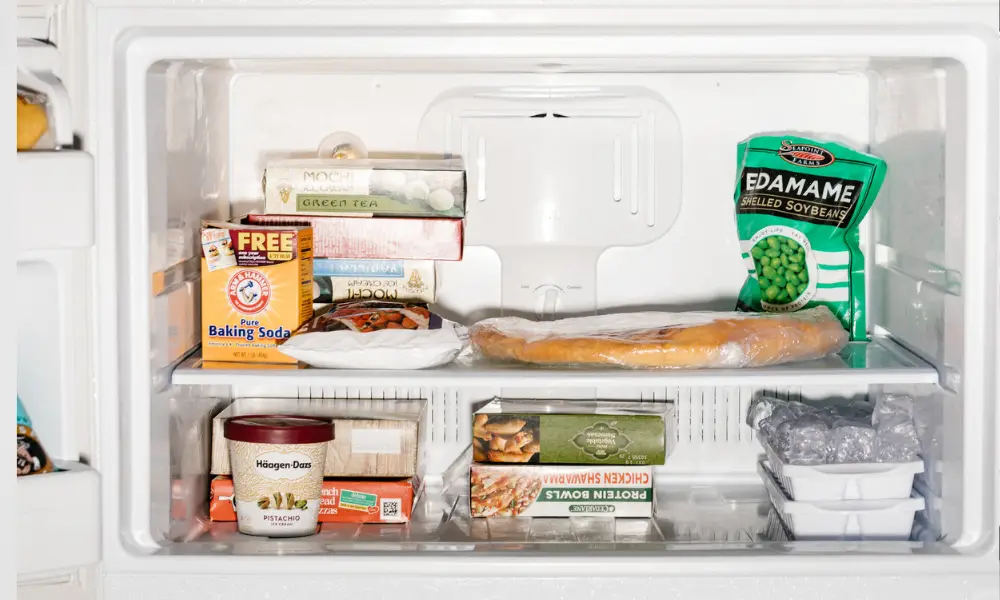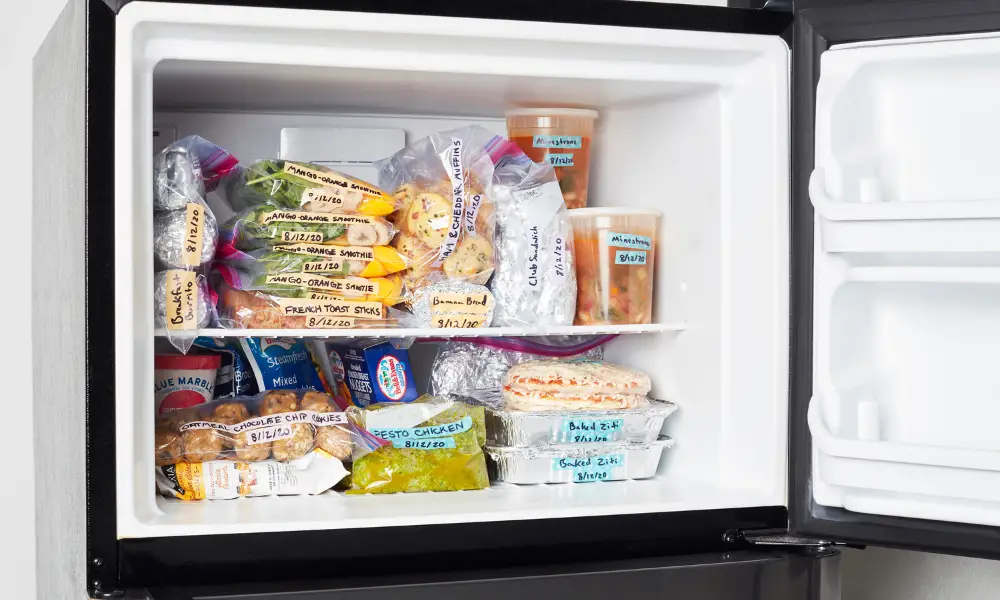Whenever you set a temperature on your freezer, there are some things that you have to keep in mind. You want to ensure you don’t burn the food you put in your freezer. It would be best to keep the temperature in your freezer constant. Luckily, there are ways to do this, and you don’t have to worry about what temperature to set your freezer.
Keeping your refrigerator and freezer temperatures within the recommended range is essential to maintaining food safety and freshness. By doing so, you’ll also save energy and prevent food waste. The refrigerator temperature range depends on the type of product you’re storing. Generally, the coldest zone is located at the bottom of the fridge. This is the ideal place to store frozen foods.

How to Know What Temp to Set your Freezer at?
A freezer should generally be kept as close to 0°F as possible, except when adding a lot of fresh, warmer food. A flash freeze feature is available on some freezers, which lowers the freezer’s temperatures for 24 hours to prevent freezer burn from temperature changes.
A freezer with a lot of ice buildup is a solid sign that the temperature is too low. You can manually lower the freezer’s temperature for a few hours, but don’t forget to adjust it. Maintaining your freezer at a too-low temperature may increase your energy costs and result in food losing moisture and flavor.
Setting the freezer’s temperature is simple: Find the dial that sets the temperature in your freezer, and turn it to the coldest position if necessary. This is often the highest number if the dial is based on numbers, but always double-check the appliance’s instructions to be sure.
Again, ensure your freezer is working at the right temperature by getting a cheap freezer thermometer to check the temperature. You should also make sure to defrost your freezer sometimes to maintain it running smoothly.
What to do if Freezer is Not Cooling Anything?
Ensure your freezer is set to the proper temperature if it isn’t maintaining its cool. Check the refrigerator’s temperature with an appliance thermometer to ensure it is lower than 40°F.
If the temperature is above 40°F, try changing the settings, then wait 24 hours before checking again. The owner’s handbook in your refrigerator should be read for more in-depth information and troubleshooting if your refrigerator is already set to the lowest temperature or if changing the setting doesn’t resolve the problem.
What is Freezer Burn?
Moisture loss is the cause of freezer burn. Any food that has been frozen for a long time is susceptible.
All foods include water, which, when frozen, produces thousands of ice crystals. Through a process known as sublimation, these crystals move to the food surface and eventually reach the coldest area of your freezer.
Evaporation and sublimation are comparable. However, sublimation doesn’t use the liquid. A material instead instantly transforms from a solid into a gas. It explains why ice crystals shrink in size after being inactive for a while.
Dehydration brought on by this loss of water molecules leads the frozen food to become harsh, dry, and shriveled. Additionally, water loss makes it possible for oxygen to alter the flavor and color of foods, particularly meats, poultry, and fish that were not wrapped well.
Foods are more likely to develop freezer burn and lose quality the longer they are kept in the freezer.
How can I Prevent Freezer Burn?
You can reduce freezer burn by maintaining your freezer at 0°F (-18°C) or lower. At this temperature, food freezes more quickly, resulting in smaller ice crystal formation. These have a lower likelihood of dramatically altering the quality of your food than larger crystals.
Additionally, it’s critical to bag your food to reduce air exposure correctly. As an illustration, wrap meat, poultry, or seafood in foil first, then in freezer paper or plastic wrap, and last in a freezer bag.
Frozen fruits and vegetables should be packaged with as little air as possible, and leftovers should be frozen in tiny containers to reduce space. Before replacing the lid, you can also wrap some freezer paper or plastic wrap around the ice cream’s top.
The temperature inside your freezer changes when you open it frequently, and other ice crystals develop when the food begins to thaw. So, open it when required.
Utilizing your frozen food more quickly is the greatest approach to preventing freezer burn. Buy only what you’ll need in the next two to four months, and label food packaged for the freezer with the date so you may consume the oldest items first.
What are the Common Problems Associated with Freezers?
The Freezer is too Cold
Your freezer can be excessively chilly. You might have a broken defrost heater if you notice that a lot of your food has excessive amounts of ice or frost, but the refrigerator is still warm.
Every bit of frost that accumulates on the evaporator coils is removed by this gadget. However, if something goes wrong, the frost will accumulate and prevent air from entering and exiting the system.
It would be best to defrost the freezer to maintain a stable temperature regularly.
The Freezer is too Warm
The safety of the food within your freezer could also be compromised by being too warm, which is a bigger problem.
The thermostat in your freezer may be defective if running too warm. This means it won’t be able to precisely determine the temperature and inform the appliance of how chilly the freezer should be.
It might also imply that the sealant is ineffective, allowing cold air to escape rather than being kept inside. To start, ensure no food is blocking the door from closing. This may be a challenging problem for you to resolve on your own.
It is Whistling too Loudly
Since most freezers don’t create a lot of noise, when they do, it can be disruptive.
If your freezer generates a lot of noise, the evaporator may malfunction. The fan may experience problems because of the frost, resulting in loud noises.
It is preferable to consult a professional for this issue because it might be challenging to resolve on your own.
What are the Advantages of Using a Freezer?
Bulk Holding
Bulk shopping is no longer a major concern if you have a freezer. Many people may not have the opportunity to buy as frequently as they would like due to their busy lives. Bf, you have a freezer. Therefore, one of the main advantages of freezers is their capacity to keep vast quantities of food.
Cooking in Bulk
A freezer also allows one to cook in bulk, saving time for other family activities. You may conveniently enjoy your favorite healthy dishes as often as possible when cooking in quantity. You microwave the food you are craving to thaw it, and you are ready to go!
Additional Preservation
We can benefit from and even overcome the seasonality of food by using a freezer. Vegetables and meat that spoil easily can be prepared and securely stored for months. Fruits in season, such as berries, pineapples, and so on, can be frozen and eaten out of season. This approach enables families and businesses to save money because most foods become more expensive during their off-seasons.
What Makes a Chest Freezer the Best Freezer from Other Freezers?
People often pick a chest freezer as their ideal piece of freezing equipment for a variety of factors. We have outlined some of the major plus factors for your freezer equipment below to assist you in making a better-informed decision.
Chest Freezers have Greater Capacity.
If you need a freezer to keep food for a large household or a public area, you will need a lot of storage space and cannot afford to squander any of it. Because they can carry more food per square foot than any other freezer form, chest freezers are the best option in this scenario.
Before you purchase, consider your storage needs. If you feel you could benefit from that extra storage space, this is the unit for you.
Chest Freezers are More Effective
A chest freezer’s door opens and closes vertically, and the door’s weight contributes to a tighter seal than you may get with another kind of freezer. This increases the seal’s dependability and lessens the possibility that any cold air will escape, which might be an expensive mistake and raise your utility expenses.
Reference: Application of natural refrigerant propane and propane/isobutane in a large-capacity chest freezer
R290 and its blends’ thermodynamic and refrigeration characteristics have been studied through theoretical analysis and experimental testing to determine how they might be applied to high-capacity freezers. According to the theoretical analysis, R290 has greater mass and volumetric refrigeration capacities than R134a by 87.7% and 54.2%, respectively.
Propane/isobutene (R290/R600a, 90/10 wt%) has greater volumetric refrigeration capacities and coefficients of performance (COP) than R134a by 48.3% and 2.4%, respectively. As a result, R290 and its blends (R290/R600a) can replace R134a while still providing big-capacity refrigeration and energy efficiency.
Conclusion
The optimal refrigerator temperature is between 35degF and 38degF. This range should be maintained to minimize bacteria growth. You can adjust the temperature to achieve this ideal level using a thermometer.
The freezer temperature range is generally much colder. This is because it is designed to prevent bacteria growth. If you’re planning on storing perishable foods, keep them below 5degC. This will stop the bacteria from multiplying and help prevent electricity costs.

